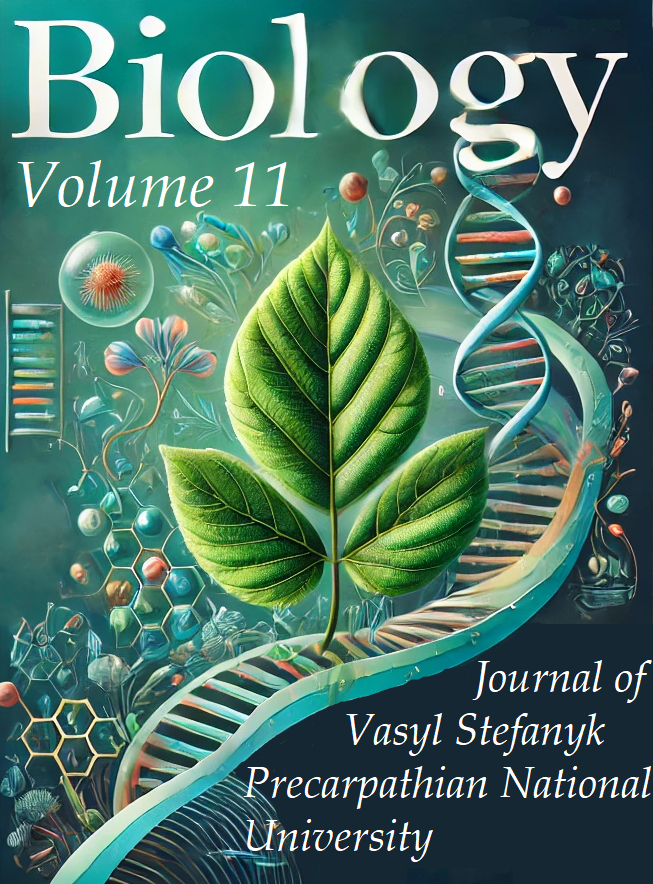Лісова рекультивація техногенних земель на прикладі золошлаковідвалів
DOI:
https://doi.org/10.15330/jpnubio.11.146-155Ключові слова:
лісова рекультивація, фіторекультивація, техногенні ландшафти, екологічне відновленняАнотація
Лісова рекультивація техногенних ландшафтів – це комплекс заходів, спрямованих на вирішення екологічних проблем, що спричинені техногенною трансформацією навколишнього середовища. Представлене дослідження описує особливості формування деревної рослинності на золошлаковідвалах Бурштинської ТЕС, розкриваючи концепцію відновлення деградованих екосистем шляхом лісової рекультивація. Аналіз видового різноманіття та екологічних характеристик дендрофлори золошлаковідвалів розкриває закономірності спонтанної сукцесії та перспективи фітомеліоративних заходів. Результати дослідження показали переважання аборигенних видів (65 % видового спектру) у дендрофлорі золошлаковідвалу № 3, що ставить під сумнів попередні припущення про заселення адвентивними видами антропогенно трансформованих ландшафтів. Піонерні види, серед яких Betula pendula, Salix caprea та Populus spp., завдяки здатності швидко формувати деревостани та ініціювати складні сукцесійні процеси, зарекомендували себе як ключові види для лісової рекультивації в умовах техногенних екотопів. Такі азотфіксуючі види як Alnus glutinosa та Hippophae rhamnoides мають вагоме значення для встановлення рослинності на збіднених на поживні речовини техногенних субстратах. Результатом дослідження є список рекомендованих для лісової рекультивації деревних та чагарникових видів, що завдяки їх екологічним особливостям та адаптивному потенціалу можуть бути ефективними для відновлення техногенно трансформованих ландшафтів. Практичні рекомендації щодо лісової рекультивації включають також ряд заходів, що сприятимуть відновленню рослинного покриву на техногенних субстратах. Запропонований комплексний підхід до лісової рекультивації закладає теоретичне підґрунття для розробки заходів відновлення деградованих промислових територій та перетворення їх у функціональні екосистеми.
Посилання
Adams, M. B. (Ed.). (2017). The Forestry Reclamation Approach: guide to successful reforestation of mined lands. U.S. Department of Agriculture, Forest Service, Northern Research Station. https://doi.org/10.2737/NRS-GTR-169
Alday, J., Santana, V., Marrs, R., & Ruiz, C. (2014). Shrub-induced understory vegetation changes in reclaimed mine sites. Ecological Engineering, 73, 691–698. https://doi.org/10.1016/j.ecoleng.2014.09.079
Aronson, J., Clewell, A., & Moreno-Mateos, D. (2016). Ecological restoration and ecological engineering: Complementary or indivisable? Ecological Engineering, 91, 392-395. https://doi.org/10.1016/j.ecoleng.2016.02.043
Bhatia, U., Dubey, S., Gouhier, T. C., et al. (2023). Network-based restoration strategies maximize ecosystem recovery. Communications Biology, 6, 1256. https://doi.org/10.1038/s42003-023-04300-0
Brown, R. W., & Amacher, M. C. (2010). Selecting plant species for ecological restoration: A perspective for land managers. Restoration Ecology, 18(3), 300-310. https://doi.org/10.1111/j.1526-100X.2009.00583.x
Center for Ecology and Development of New Technologies. (2019). Environmental Impact Assessment Report for Ash Dump Buildings 1–2 (reconstruction) "Burshtynska TPP" "DTEK ZAKHIDENERGO".
Didukh, Y. P. (Ed.). (2000-2010). Ecoflora of Ukraine. Vol. 1-6. Phytosociocentr.
Gajic, G., Djurdjević, L., Kostic, O., Jarić, S., Mitrović, M., & Pavlović, P. (2018). Ecological Potential of Plants for Phytoremediation and Ecorestoration of Fly Ash Deposits and Mine Wastes. Frontiers in Environmental Science, 6, 124. https://doi.org/10.3389/fenvs.2018.00124
Kiehl, K., Kirmer, A., Donath, T. W., & Hölzel, N. (2010). Species introduction in restoration projects: Evaluation of different techniques for the establishment of semi-natural grasslands in Central and Northwestern Europe. Basic and Applied Ecology, 11(4), 285-299. https://doi.org/10.1016/j.baae.2009.12.004
Kirmer, A., Jeschke, D., Kiehl, K., & Tischew, S. (2019). Praxisleitfaden zur Etablierung und Aufwertung von Säumen und Feldrainen (2nd ed.). Hochschule Anhalt. ISBN 978-3-86011-075-1.
Klotz, S., Kühn, I. and Durka, W. 2002 (eds.). BIOLFLOR – Eine Datenbank zu biologisch-ökologischen Merkmalen der Gefäßpflanzen in Deutschland. Schriftenreihe für Vegetationskunde 38. Bonn: Bundesamt für Naturschutz. 334 pp.
Kovaliv, L. N. (2013). Environmental problems of thermal power. Scientific Bulletin of UNFU, 23(18), 57–56.
Krasova, O. O., Shkuta, S. I., & Pavlenko, A. O. (2022). The current state of coenopopulations of shrubs of family Rosaceae Juss. on the iron ore dumps of Kryvyi rih area. Scientific Bulletin of UNFU, 32(5), 07–12. https://doi.org/10.36930/40320501
Lin, Y., Fang, L., Zhou, W., Qiao, Z., Chang, Y., Yu, X., Li, Y., Ren, P., & Xiao, J. (2024). Evaluating the long-term effects of near-natural restoration on post-fire forest dynamics in a wildland-urban interface landscape. Ecological Indicators, 160, 111777. https://doi.org/10.1016/j.ecolind.2024.111777
Łuczak, K., Kusza, G., Daria, S., & Krystyna, B. (2019). Fruit trees and bushes as a biodiversity element in the “Górażdże” Quarry reclaimed areas. Journal of Ecological Engineering, 20(3), 24–29. https://doi.org/10.12911/22998993/99307
Martiník, A., Adamec, Z., Sendecký, M., & Krejza, J. (2024). Comparison of growth, structure and production in stands of naturally regenerated Betula pendula and Populus tremula. Journal of Forest Science, 70, 64–78. https://doi.org/10.17221/107/2023-JFS
Mosyakin, S. L., & Fedoronchuk, M. (Eds.). (1999). Vascular plants of Ukraine: A nomenclatural checklist. M. G. Kholodny Institute of Botany, National Academy of Sciences of Ukraine. https://doi.org/10.13140/2.1.2985.0409
Mustafa, B., et al. (2012). Vegetation of the Ash Dump of the "Kosova A" Power Plant and the Slag Dump of the "Ferronikeli" Smelter in Kosovo. Research Journal of Environmental and Earth Sciences, 4(9), 823–834. https://doi.org/10.3923/rjees.2012.823.834
Mylenʹka, M. M. (2009). Bioindication assessment of the ecological condition of the Burshtyn urban ecosystem [Doctoral dissertation]. Dnipropetrovsk National University named after O. Gonchar.
Nissim, W. G., & Labrecque, M. (2021). Reclamation of urban brownfields through phytoremediation: Implications for building sustainable and resilient towns. Urban Forestry & Urban Greening, 65, 127364. https://doi.org/10.1016/j.ufug.2021.127364.
Pandey, D. N., & Singh, N. (2015). Sustainable phytoremediation based on naturally colonizing and economically valuable plants. Journal of Cleaner Production, 86, 37-39. https://doi.org/10.1016/j.jclepro.2014.08.014
Pietrzykowski, M. (2019). Tree species selection and reaction to mine soil reconstructed at reforested post-mine sites: Central and eastern European experiences. Ecological Engineering, 133, 100012. https://doi.org/10.1016/j.ecoena.2019.100012
Prach, K., & Hobbs, R. J. (2008). Spontaneous succession versus technical reclamation in the restoration of disturbed sites. Restoration Ecology, 16(3), 363-366. https://doi.org/10.1111/j.1526-100X.2008.00412.x
Rathfon, R., et al. (2015). Tree and shrub species selection for mine reclamation in the Midwest region of USA. ARRI Forest Reclamation Advisory No. 13. https://doi.org/10.2737/NRS-RN-13
Řehounková K., Řehounek J., Prach K. (eds.) (2011): Near-natural restoration vs. technical reclamation of mining sites in the Czech Republic, University of South Bohemia in České Budějovice, České Budějovice, 112 pp.
Savosko, V., et al. (2021). Dendroflora of post-mining regions. Forest Ecology and Management, 487, 118-129. https://doi.org/10.1016/j.foreco.2021.118129
Šebelíková, L., et al. (2019). Spontaneous revegetation versus forestry reclamation—Vegetation development in coal mining spoil heaps across Central Europe. Land Degradation & Development, 30(3), 348–356. https://doi.org/10.1002/ldr.3205
Tischew, S., & Lorenz, A. (2005). Spontaneous Development of Peri-Urban Woodlands in Lignite Mining Areas of Eastern Germany. In I. Kowarik, S. Körner (Eds.), Urban Wild Woodlands (pp. 163–180). Springer Verlag. https://doi.org/10.1007/3-540-29166-0_12
Yuan, Y., Zhao, Z., Niu, S., & Bai, Z. (2020). The reclaimed coal mine ecosystem diverges from the surrounding ecosystem and reaches a new self-sustaining state after 20–23 years of succession in the Loess Plateau area, China. Science of the Total Environment, 727, 138739. https://doi.org/10.1016/j.scitotenv.2020.138739
Zhang, K. R., Zhang, X. Q., Li, Q., Zhao, M. S., Wang, L. Z., & Zhang, Q. F. (2023). Near-natural precise restoration of degraded ecosystems: Nature-based solutions. Plant Science Journal, 41(6), 751−758. https://doi.org/10.3969/j.issn.1000-470X.2023.06.007
Żołnierz, L., Weber, J., Gilewska, M., Strączyńska, S., & Pruchniewicz, D. (2015). The spontaneous development of understory vegetation on reclaimed and afforested post-mine excavation filled with fly ash. Catena, 133, 250-259. https://doi.org/10.1016/j.catena.2015.07.013
World Flora Online (WFO). (n.d.). Home page. Retrieved December 20, 2024, from https://www.worldfloraonline.org/






